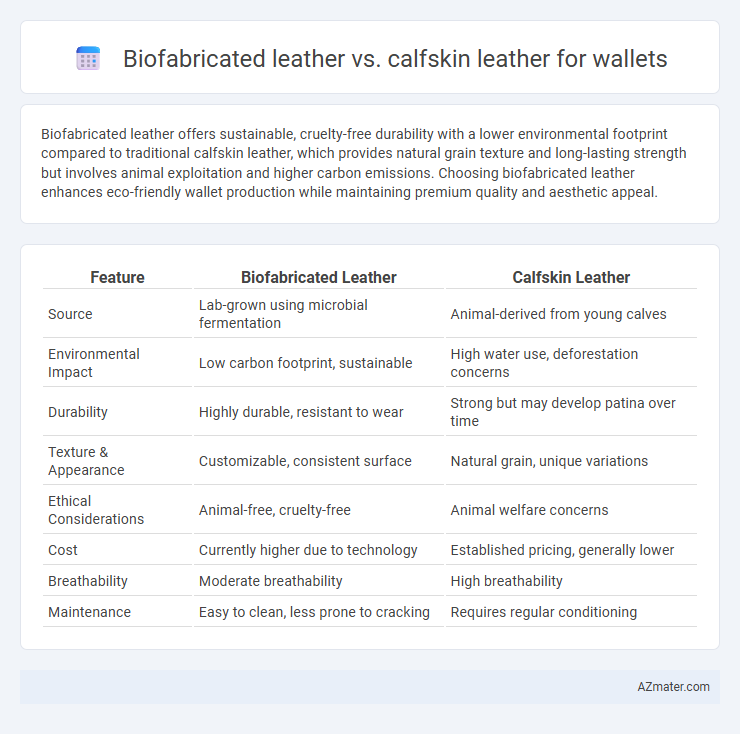Biofabricated leather offers sustainable, cruelty-free durability with a lower environmental footprint compared to traditional calfskin leather, which provides natural grain texture and long-lasting strength but involves animal exploitation and higher carbon emissions. Choosing biofabricated leather enhances eco-friendly wallet production while maintaining premium quality and aesthetic appeal.
Table of Comparison
| Feature | Biofabricated Leather | Calfskin Leather |
|---|---|---|
| Source | Lab-grown using microbial fermentation | Animal-derived from young calves |
| Environmental Impact | Low carbon footprint, sustainable | High water use, deforestation concerns |
| Durability | Highly durable, resistant to wear | Strong but may develop patina over time |
| Texture & Appearance | Customizable, consistent surface | Natural grain, unique variations |
| Ethical Considerations | Animal-free, cruelty-free | Animal welfare concerns |
| Cost | Currently higher due to technology | Established pricing, generally lower |
| Breathability | Moderate breathability | High breathability |
| Maintenance | Easy to clean, less prone to cracking | Requires regular conditioning |
Introduction to Biofabricated and Calfskin Leather
Biofabricated leather is an innovative material created through cell culture technology that replicates the texture and durability of traditional leather without involving animal farming. Calfskin leather, derived from young cattle hides, is prized for its softness, fine grain, and long-lasting strength in premium wallets. Comparing biofabricated leather and calfskin leather involves evaluating sustainability, ethical production, and material performance.
Defining Biofabricated Leather: Process and Properties
Biofabricated leather is created through culturing animal cells in a controlled environment, eliminating the need for traditional livestock farming and reducing environmental impact. This innovative material replicates the texture, durability, and flexibility of calfskin leather while offering enhanced sustainability and ethical benefits. By harnessing biotechnology, biofabricated leather ensures consistent quality and reduces chemical usage compared to conventional tanning processes used in calfskin leather production.
Calfskin Leather: Traditional Craftsmanship and Features
Calfskin leather is prized for its fine grain, softness, and durability, making it a premium choice for wallet craftsmanship. This traditional material undergoes meticulous tanning and finishing processes that enhance its natural texture and develop a rich patina over time. Skilled artisans rely on calfskin's pliability and strength to create wallets that combine elegance with long-lasting functionality.
Environmental Impact: Biofabricated vs Calfskin Leather
Biofabricated leather significantly reduces environmental impact by eliminating the need for animal farming, which contributes to deforestation, methane emissions, and excessive water use associated with calfskin leather production. The process of cultivating biofabricated leather typically consumes less water and energy while producing fewer greenhouse gases compared to traditional leather tanning. As a sustainable alternative, biofabricated leather supports ethical manufacturing and minimizes ecological footprint in wallet production.
Durability and Longevity of Wallets
Biofabricated leather demonstrates enhanced durability and longevity in wallet production through its engineered resistance to wear, moisture, and environmental stress compared to traditional calfskin leather. Unlike calfskin, which naturally ages and can develop cracks or discoloration over time, biofabricated leather maintains structural integrity and flexibility, extending the wallet's lifespan significantly. The controlled manufacturing process of biofabricated leather ensures consistent quality and performance, making it a superior choice for consumers focused on long-term durability.
Aesthetic Appeal: Texture, Color, and Finish
Biofabricated leather offers a consistent texture with customizable color options, providing a modern, sleek finish ideal for wallets seeking a contemporary aesthetic. Calfskin leather boasts a natural grain and rich, deep hues that develop unique patinas over time, enhancing wallet character and luxury appeal. The matte to semi-gloss finishes of calfskin emphasize its organic origin, while biofabricated leather often presents a uniform sheen tailored to specific design preferences.
Ethical and Animal Welfare Considerations
Biofabricated leather for wallets offers a cruelty-free alternative to traditional calfskin leather by eliminating the need to raise and slaughter animals, reducing animal suffering significantly. This innovative material is developed using lab-grown cells, ensuring ethical sourcing and minimizing environmental impact compared to calfskin, which often involves intensive farming practices. Choosing biofabricated leather supports animal welfare by promoting sustainable, humane production methods while maintaining durability and aesthetic qualities valued in wallet craftsmanship.
Cost Comparison and Market Availability
Biofabricated leather for wallets typically incurs higher production costs due to advanced biotechnology processes, making it more expensive than traditional calfskin leather, which benefits from established supply chains and economies of scale. Calfskin leather wallets dominate the market with widespread availability in retail and online stores, while biofabricated leather wallets remain niche, often limited to specialty brands and direct-to-consumer channels. Consumer demand and technological advancements are gradually increasing biofabricated leather's market presence, but calfskin leather continues to offer more affordable and readily accessible options.
Consumer Perception and Trends
Biofabricated leather resonates with eco-conscious consumers seeking sustainable wallet options, driven by rising awareness of environmental impact and animal welfare. Calfskin leather maintains its appeal among traditional buyers valuing durability, luxury, and craftsmanship associated with premium wallets. Market trends indicate a growing shift towards biofabricated materials as innovation and affordability improve, aligning wallets with evolving consumer values.
Choosing the Right Leather for Your Wallet
Biofabricated leather offers a sustainable alternative to traditional calfskin leather, reducing environmental impact while maintaining durability and a premium feel ideal for wallets. Calfskin leather remains a classic choice due to its softness, natural grain, and long-lasting wear, appealing to those valuing authenticity and age-developed patina. Selecting the right leather depends on priorities such as eco-friendliness, texture preference, and anticipated wallet lifespan, with biofabricated leather excelling in innovation and calfskin in timeless quality.

Infographic: Biofabricated leather vs Calfskin leather for Wallet
 azmater.com
azmater.com